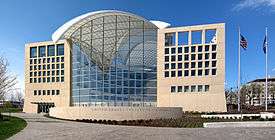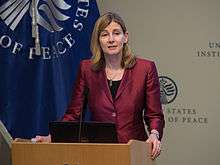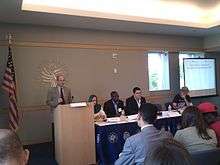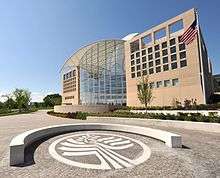United States Institute of Peace
The United States Institute of Peace (USIP) is an American federal institution tasked with promoting conflict resolution and prevention worldwide. It provides research, analysis, and training to individuals in diplomacy, mediation, and other peace-building measures.
 USIP's headquarters in Washington, D.C., finished construction in 2011 | |
| Abbreviation | USIP |
|---|---|
| Motto | Making Peace Possible |
| Formation | 1984 |
| Headquarters | United States Institute of Peace Headquarters 2301 Constitution Avenue NW |
| Location | |
President | Nancy Lindborg |
Budget | $37.8 million (2018)[1] |
| Website | www |
Following years of proposals for a national "peace academy", the USIP was established in 1984 by Congressional legislation signed into law by President Ronald Reagan. It is officially nonpartisan and independent, receiving funding only through a congressional appropriation to prevent outside influence. The Institute is governed by a bipartisan board of directors with fifteen members—which must include the secretary of defense, the secretary of state, and the president of the National Defense University—who are appointed by the president and confirmed by the Senate.
The Institute's headquarters is in the Foggy Bottom neighborhood of Washington, D.C., situated at the northwest corner of the National Mall near the Lincoln Memorial and Vietnam Veterans Memorial. It currently employs around 300 personnel and has trained more than 65,000 professionals since its inception.
Mission
The United States Institute of Peace Act, passed in 1984, calls for the Institute to "serve the people and the Government through the widest possible range of education and training, basic and applied research opportunities, and peace information services on the means to promote international peace and the resolution of conflicts among the nations and peoples of the world without recourse to violence".[2]
The Institute carries out this mission by operating programs in conflict zones, conducting research and analysis, operating a training academy[3] and public education center,[4] providing grants for research and fieldwork, convening conferences and workshops,[5] and building the academic and policy fields of international conflict management and peacebuilding.[6] On many of its projects, the Institute works in partnership with non-governmental organizations, higher and secondary educational institutions, international organizations, local organizations, and U.S. government agencies, including the State Department and the Department of Defense.[7]
History

President Ronald Reagan signed the United States Institute of Peace Act in 1984.[2]
Spurred by a grassroots movement in the 1970s and 1980s, Senator Jennings Randolph joined senators Mark Hatfield and Spark Matsunaga and Representative Dan Glickman in an effort to form a national peace academy akin to the national military academies.[8] The 1984 act creating USIP followed from a 1981 recommendation of a commission formed to examine the peace academy issue appointed by President Jimmy Carter and chaired by Matsunaga.
Robert F. Turner was the Institute's first president and CEO, holding that position from 1986 to 1987. He was followed by Ambassador Samuel W. Lewis (1987–1992), Ambassador Richard H. Solomon, (1992–2012), and former congressman Jim Marshall (2012–2013). Kristin Lord served as acting president (2013–2014). Nancy Lindborg was sworn in as president on February 2, 2015. In its early years, the Institute sought to strengthen international conflict management and peacebuilding. In a 2011 letter of support for USIP, the Association of Professional Schools of International Affairs stated that this analytical work has "helped to build the conflict management and resolution field, both as an area of study and as an applied science".[6]
Under Solomon's leadership, the Institute expanded its operations in conflict zones and its training programs, initially in the Balkans and, after September 11, 2001, in Afghanistan and Iraq.[9] It also became the home of several congressionally mandated blue-ribbon commissions, including the Iraq Study Group, the Congressional Commission on the Strategic Posture of the United States, and the Quadrennial Defense Review Independent Panel. Today, the Institute conducts active programs in Afghanistan, Iraq, Libya, Pakistan, Sudan, South Sudan, and elsewhere.[5]
In 1996, Congress authorized the Navy to transfer jurisdiction of the federal land—a portion of its Potomac Annex facility on what has been known as Navy Hill—to become the site of the permanent USIP headquarters, across the street from the National Mall at 23rd Street and Constitution Avenue NW, in Washington, D.C.[10] Prior to its construction, the Institute leased office space in downtown Washington. Construction of the headquarters building concluded in 2011.
An article in the July/August 1990 issue of politically progressive, left wing[11][12] Z Magazine stated that the supposed peace research "looks more like the study of new and potential means of aggression."[13]
Budget

USIP is funded annually by the U.S. Congress. For fiscal year 2012 Congress provided $39 million.[14] Occasionally, USIP receives funds transferred from government agencies, such as the Department of State, USAID, and the Department of Defense. By law, USIP is prohibited from receiving private gifts and contributions for its program activities. The restriction on private fundraising was lifted for the public-private partnership to construct the USIP headquarters.
Budget debate
An op-ed in the Wall Street Journal on February 16, 2011, by Republican congressman Jason Chaffetz of Utah and former Democratic congressman Anthony Weiner of New York, attacked funding for USIP as part of the broader debate about federal spending. "The USIP is a case study in how government waste thrives", they wrote. "The idea began during the Cold War as a modest proposal with $4 million in seed money. But the organization received government funding year after year essentially because it had been funded the year before—and because it had important allies."[15]
Former U.S. Central Command commander Anthony Zinni wrote an op-ed, published in the New York Times on March 7, 2011, in support of USIP. "Congress would be hard-pressed to find an agency that does more with less. The institute's entire budget would not pay for the Afghan war for three hours, is less than the cost of a fighter plane, and wouldn't sustain even 40 American troops in Afghanistan for a year. Within the budget, peace-building is financed as part of national security programs and is recognized as an important adjunct to conventional defense spending and diplomacy. The institute's share of the proposed international affairs budget, $43 million, is minuscule: less than one-tenth of one percent of the State Department's budget, and one-hundredth of one percent of the Pentagon's."[16]
On February 17, 2011, the House of Representatives for the 112th U.S. Congress voted to eliminate all funding for the U.S. Institute of Peace in FY 2011 continuing resolution.[17][18] Funding for the Institute was eventually restored by both the House and Senate on April 14, 2011, through the Department of Defense and Full-Year Continuing Appropriations Act of 2011.[19]
Organization and leadership
The Institute's staff of more than 300[20] is split among its Washington headquarters, field offices, and temporary missions to conflict zones. The Institute is active in some 17 countries,[21] and as of 2012 maintains field offices in Kabul, Afghanistan, and Baghdad, Iraq, as well as a presence in Islamabad, Pakistan.
Organization

USIP coordinates its work through five main centers:
- Center for South and Central Asia (SCA)
- Center for Governance, Law, and Society (GLAS)
- Center for the Middle East and Africa (MEA)
- Center for Applied Research on Conflict (ARC)
- The Academy for International Conflict Management and Peacebuilding
Leadership
The Institute is governed by a board of directors, with an equal number of Republican and Democratic directors appointed by the president of the United States and confirmed by the Senate.[22] Nancy Lindborg is the current president of the Institute, having served in that role since 2015. She was preceded by Kristin Lord (Acting President 2013-2014), former congressman Jim Marshall (President 2012-2013), former senior State Department official and U.S. ambassador to the Philippines Richard H. Solomon (President 1992-2012), former U.S. ambassador to Israel Samuel W. Lewis (President 1987-1988), and Robert F Turner (President 1986-1987).
Board of directors
- Stephen Hadley, Chairman – Principal, Rice Hadley Gates, LLC
- George E. Moose, Vice Chairman – The George Washington University, Adjunct Professor of Practice
- Judy Ansley – Former assistant to the president and deputy national security advisor at the National Security Council (NSC)
- Eric S. Edelman – former under secretary of defense for policy, U.S. Department of Defense
- Kerry Kennedy – human rights activist and former executive director of the Robert Kennedy Memorial
- Ikram U. Khan – President, Quality Care Consultants, LLC
- Stephen D. Krasner – Stanford University, Graham H. Stuart Professor of International Relations
- John A. Lancaster – National Council on Independent Living (NCIL), former Executive Director
- Jeremy A. Rabkin – Antonin Scalia Law School, Professor
- J. Robinson West, Chairman – PFC Energy, Chairman
- Nancy Zirkin – Leadership Conference on Civil Rights, Executive Vice President
- Members ex officio
- James Mattis – Secretary of Defense (or his designee)
- Mike Pompeo – Secretary of State, State Department (or his designee)
- Major General Gregory S. Martin – President, National Defense University
Projects
PeaceTech Lab
The PeaceTech Lab is a 501(c)3 spun out of the United States Institute of Peace in 2014. It created the lab as a separate entity to further advance its core mission to prevent, mitigate, and reduce violent conflict around the world. The lab continues USIP's work developing technology and media tools for peacebuilding. In real terms, the lab brings together engineers, technologists, and data scientists from industry and academia, along with experts in peacebuilding from USIP, other government agencies, NGOs, and the conflict zones. These experts collaborate to design, develop, and deploy new and existing technology tools for conflict management and peacebuilding.[23]
Convened tribes in Iraq
In Iraq in 2007, USIP helped broker the initial peace agreement that is seen as the turning point in the war there. USIP experts were asked to assist the U.S. Army's 10th Mountain Division in the reconciliation effort in Mahmoudiya, located in what was known as "the Triangle of Death" in Iraq's western Al Anbar Governorate. USIP was seen as a neutral player that was able to convene Sunni tribal leaders, Iraq's Shiite government leaders, and senior members of the U.S. military. Soon after the meeting, attacks and casualties declined significantly. The agreement led to a reduction of the U.S. military presence there from a brigade-level unit of about 3,500 soldiers to a battalion-level unit of about 650. General David Petraeus, the senior commander in Iraq, noted that the turnabout was "striking". Petraeus also said that USIP "is a great asset in developing stronger unity of effort between civilian and military elements of government".[24]
Iraq Study Group
The U.S. government used USIP to help convene the bipartisan Iraq Study Group in 2006 that studied the conflict in Iraq and recommended ways forward. USIP facilitated the group's trip to Iraq and hosted several meetings of the group. According to USIP, the group's political neutrality made it an appropriate entity to host the group's sensitive deliberations. The effort was undertaken at the urging of several members of Congress with agreement of the White House. A final report was released to Congress, the White House, and the public on December 6, 2006.[25]
Genocide Prevention Task Force
In Fall 2008, U.S. Institute of Peace, the U.S. Holocaust Memorial Museum, and the American Academy of Diplomacy jointly convened the Genocide Prevention Task Force to "spotlight genocide prevention as a national priority and to develop practical policy recommendations to enhance the capacity of the U.S. government to respond to emerging threats of genocide and mass atrocities".[26]
The 14-member task force,[27] co-chaired by former secretary of state Madeleine Albright and former defense secretary William Cohen, outlined "a national blueprint to prevent genocide and mass atrocities".[28] In December 2008, the task force released its report "Preventing Genocide: A Blueprint for U.S. Policymakers"[29] detailing its recommendations and guidelines. The Economist praised it as a "report steeped in good sense".[30]
On August 4, 2011, U.S. president Barack Obama announced a proclamation suspending U.S. entry to individuals active in "serious human rights and humanitarian law violations"[31] and called for the creation of an Atrocities Prevention Board to review, coordinate and develop an atrocity prevention and response policy, and incorporate recommendations provided by the Genocide Prevention Task Force.[32]
Preventing electoral violence in Sudan
Ahead of Sudan's April 2010 national elections (the first since 1986) and January 2011 South Sudanese independence referendum, USIP staff traveled to some of the more unstable regions to help prepare people for the elections. Amid heightened tensions, USIP experts focused on improving cultural awareness, citizenship skills, and training Sudanese on electoral violence triggers—all critical steps to ensure that the polls did not turn violent. The elections and referendum were held with relatively no bloodshed and were widely deemed a success. Building upon USIP's successful electoral violence prevention training, USIP is implementing a series of violence prevention workshops throughout the country post-election and post-referendum.
Publication of The Iran Primer
The Iran Primer: Power, Politics, and U.S. Policy "offers a comprehensive but concise overview of Iran's politics, economy, military, foreign policy, and nuclear program". It convenes 50 experts to discuss Iran's evolving relationship with the West and "chronicles U.S.-Iran relations under six American presidents and probes five options for dealing with Iran". The Iran Primer is edited by USIP staff member Robin Wright.[33]
Additional work
- Worked with community leaders to build peace neighborhood-by-neighborhood in Iraq
- Working with tribal chiefs, educator, and civil society leaders in support of peacemaking in Sudan
- Training hundreds of young Nigerian religious leaders, women, and youth from all over the country to be peacemakers; and helping bring peace to large parts of Plateau State
- Strengthening the peacemaking capacity of religious leaders and faith-based organizations through research, technical assistance, facilitated dialogues, and operational support
- Helping establish the rule of law, a fundamental building block to peace in Afghanistan, Iraq, Liberia, Palestine, and Nepal in addition to other security sector reform initiatives.
- Producing educational resources such as a book series on cultural negotiation, textbooks on conflict management, and online training[34]
- General reference
- The Diplomat's Dictionary
- Negotiating across Cultures: International Communication in an Interdependent World
- Arts of Power: Statecraft and Diplomacy
- Culture and Conflict Resolution
- Country-specific
- How Pakistan Negotiates with the United States: Riding the Roller Coaster
- American Negotiating Behavior: Wheeler-Dealers, Legal Eagles, Bullies, and Preachers
- Negotiating with Iran: Wrestling the Ghosts of History
- How Israelis and Palestinians Negotiate: A Cross-Cultural Analysis of the Oslo Peace Process
- French Negotiating Behavior: Dealing with La Grande Nation
- How Germans Negotiate: Logical Goals, Practical Solutions
- Case Studies in Japanese Negotiating Behavior
- Negotiating on the Edge: North Korean Negotiating Behavior
- Chinese Negotiating Behavior: Pursuing Interests Through 'Old Friends'
- Russian Negotiating Behavior: Continuity and Transition
- General reference
The institute has also served U.S. government officials and policymakers.
- Facilitating the Congressional Commission on the Strategic Posture of the United States, Genocide Prevention Task Force, and the bipartisan Iraq Study Group
- Leading a Congress-mandated, bipartisan task force on United Nations reform
- Developing a proposal for a comprehensive settlement of the Korean War, which was drawn upon by U.S. government officials in preparation for the Six-party talks
- Conducting a study of the U.S. government's state-building capacity that contributed to the creation of the Office of Reconstruction and Stabilization (ORS) in the State Department
Headquarters

In March 2011, USIP moved into its permanent headquarters facility at the northwest corner of the National Mall in Washington, D.C. Designed by Moshe Safdie Architects and Buro Happold, the LEED-certified building aims to serve as a symbol of America's commitment to peacebuilding. The building houses offices and staff support facilities, a library, a conference center, auditorium, classrooms, and a public education center.[35] Officials broke ground for the new headquarters in June 2008 at a ceremony that included President George W. Bush, Senate majority leader Harry Reid, and Speaker of the House Nancy Pelosi.[36]
Publications
USIP publishes a variety of topical newsletters, briefs, reports, guides, studies, testimony, and books related to peacebuilding and conflict management topics. It also maintains digital collections of peace agreements, oral histories, and information about truth commissions. The USIP headquarters is home to a public library that houses a collection of items related to peacebuilding, conflict management, and diplomacy. Its materials can be used on-site or requested through interlibrary loan.[37]
An article by the politically progressive[38][39] news website Truthout described USIP's decision to release the Trump administration’s 2018 National Defense Strategy on its website as a case where "lacking a sense of irony, the bureaucracy is quite happy to caricature Orwell."[40]
See also
- Title 22 of the Code of Federal Regulations
- Department of Peace
- ONU Law Rule of Law LL.M. Program
- Pacifism in the United States
References
- "Impact Where America Needs It: A USIP Fact Sheet". USIP. Retrieved 21 September 2018.
- "United States Institute of Peace Act (22 USC Ch 56, sect. 4601-4611)". U.S. House of Representatives. Retrieved 2017-01-18. See also PDF on USIP website.
- "Education and Training at USIP". United States Institute of Peace. usip.org. Retrieved 2017-01-18.
- "Global Peacebuilding Center". United States Institute of Peace. usip.org. Retrieved 2017-01-18.
- Coleman, Michael (2012-05-31). "USIP Keeping the Peace, One Conflict at a Time". The Washington Diplomat.
- "APSIA Letter of Support for the United States Institute of Peace" (PDF). 28 February 2011. Retrieved 2012-11-28.
- "Quasi-Official Agencies: United States Institute of Peace". The United States Government Manual. 2016. Retrieved 2017-01-18.
- "Below the Radar: A Federal Peace Agency". The New York Times. 2008-06-12.
- "Leon Panetta Dean Acheson Lecture: "Building Partnership in the 21st Century"". 28 June 2012. Retrieved 28 November 2012.
- "Peace institute approved to begin construction on National Mall". Associated Press. 2007-06-09. Archived from the original on 2013-02-09.
- "POLITICAL PERSPECTIVES OF MAGAZINES AND JOURNALS". Skyline College.
- Max Elbaum. Revolution in the air: sixties radicals turn to Lenin, Mao and Che. London, England, UK; New York, New York, USA: Verso, 2002. p. 296.
- Diamond, Sarah; Hatch, Richard (July/August 1990). "OPERATION PEACE INSTITUTE". Z Magazine.
- "H.R.2055 -- Consolidated Appropriations Act, 2012". 23 December 2011. Retrieved 28 November 2012.
- Chaffetz, Jason; Weiner, Anthony (2011-02-16). "Small Budget Cuts Add Up". The Wall Street Journal.
- Zinni, Anthony C. (2011-03-07). "Why Congress Should Keep Financing the U.S. Institute of Peace". The New York Times.
- Dolan, Eric (2011-02-17). "House votes to cut all funding for US Institute of Peace". The Raw Story.
- Ornstein, Norman (2011-06-01). "U.S. Institute of Peace is Target in Spending War". Roll Call.
- "H.R.1473 -- Department of Defense and Full-Year Continuing Appropriations Act, 2011". 14 April 2011. Retrieved 28 November 2012.
- "About USIP". United States Institute of Peace. Retrieved March 18, 2017.
- "Regions & Countries". United States Institute of Peace. Retrieved March 18, 2017.
- Markoe, Lauren (January 29, 2011). "In time of war, a monument to peace". Washington Post. p. B2.
- "The Peace Tech Lab: Areas of Focus". Archived from the original on 2014-12-24. Retrieved 2015-05-31.
- Mortenson, Darrin (2007-10-19). "A Local Peace Accord: Cause for Hope?". Time.
- "The Iraq Study Group". U.S. Institute of Peace. Retrieved 2007-02-03.
- "Genocide Prevention Task Force". U.S. Institute of Peace. Retrieved 2011-08-03.
- "Genocide Prevention Task Force". U.S. Institute of Peace. Retrieved 2011-08-03.
- "Never again, for real". The New York Times. 2011-12-11.
- Preventing Genocide: A Blueprint for U.S. Policymakers (PDF). Genocide (Report). Genocide Prevention Task Force. December 8, 2008. Archived from the original (PDF) on September 11, 2011. Retrieved August 3, 2011.
- "Preventing genocide". The Economist. 2008-12-11.
- "Presidential Proclamation". The White House. 2011-08-04.
- "Davis Center for Russian and Eurasian Studies". Davis Center for Russian and Eurasian Studies. Retrieved 28 August 2017.
- The Iran Primer: Power, Politics, and U.S. Policy. United States Institute of Peace.
- "Cross-Cultural Negotiation Books". United States Institute of Peace. Archived from the original on 2013-01-31. Retrieved 4 October 2012.
- Lewis, Roger (2012-02-24). "At U.S. Institute of Peace, building's provocative design doesn't entirely succeed". The Washington Post.
- Abramowitz, Michael (2008-06-06). "At Peace Institute Groundbreaking, War Dominates the Proceedings". The Washington Post.
- "Library". United States Institute of Peace.
- "Truthout.org". CSPAN.
- "About Truthout".
- Polychroniou, CJ (21 November 2018). "Noam Chomsky: Moral Depravity Defines US Politics". Truthout. Retrieved 27 November 2018.
External links
| Wikimedia Commons has media related to United States Institute of Peace. |